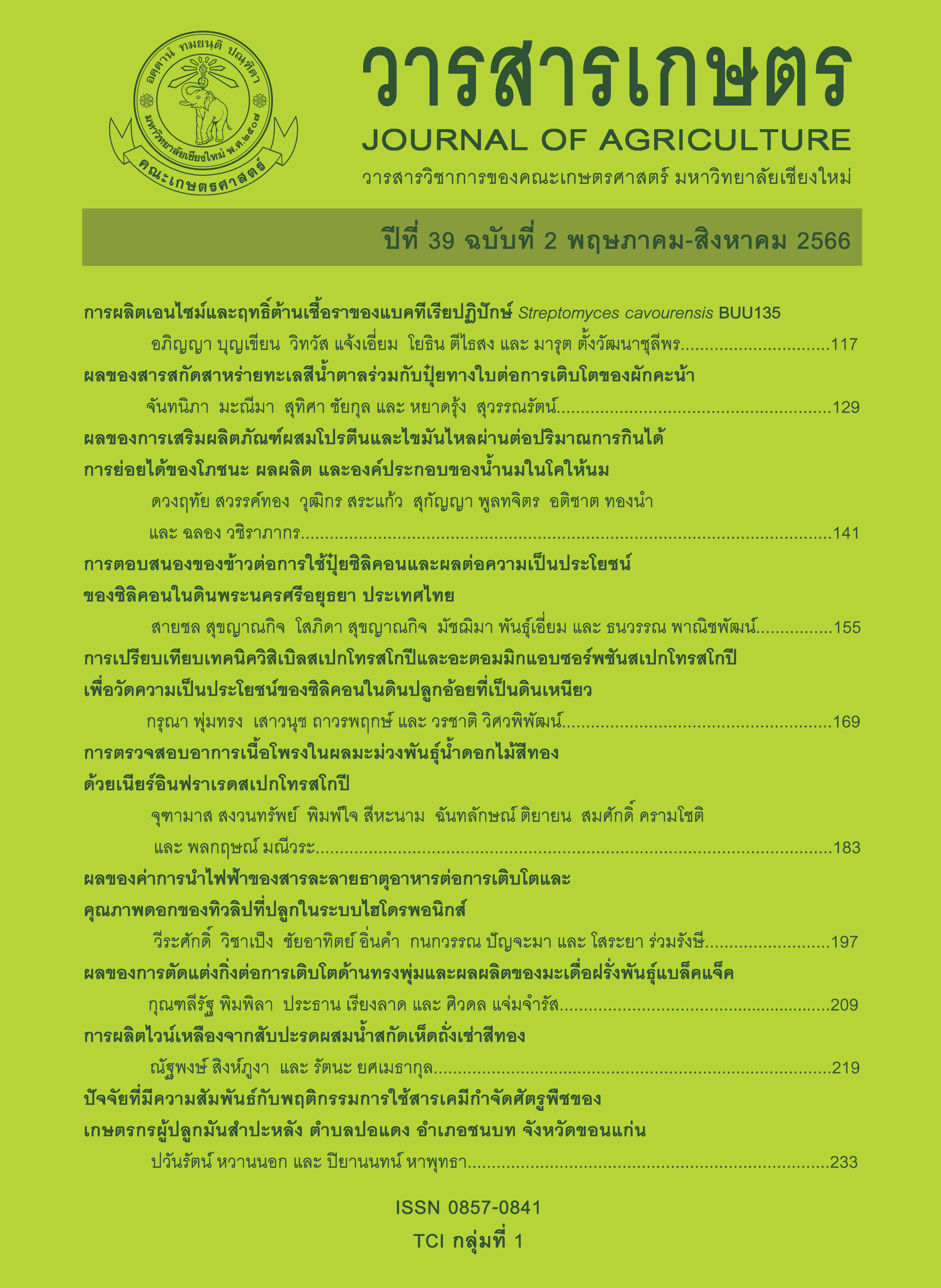การตรวจสอบอาการเนื้อโพรงในผลมะม่วงพันธุ์น้ำดอกไม้สีทองด้วยเนียร์อินฟราเรดสเปกโทรสโกปี
Main Article Content
บทคัดย่อ
การศึกษานี้มีวัตถุประสงค์เพื่อใช้เนียร์อินฟราเรดสเปกโทรสโกปี (near infrared spectroscopy: NIRS) ตรวจสอบอาการเนื้อโพรงในผลมะม่วงพันธุ์น้ำดอกไม้สีทอง โดยเก็บข้อมูลสเปกตรัมเนื้อมะม่วงปกติจำนวน 1,470 ตำแหน่ง และเนื้อโพรงจำนวน 97 ตำแหน่ง จากมะม่วง 163 ผล แล้วนำข้อมูลสเปกตรัมมาสร้างแบบจำลอง (training) ด้วยวิธีโครงข่ายประสาทเทียม (artificial neural network: ANN) เพื่อทำนายเนื้อปกติและเนื้อโพรงของมะม่วงพร้อมกับการทดสอบแบบจำลอง (validating) ด้วยวิธี K-fold cross validation ผลการวิเคราะห์ข้อมูลพบว่า แบบจำลองซึ่งใช้สเปกตรัมในช่วงความยาวคลื่นสั้นของเนียร์อินฟราเรด (12500 - 9000 cm-1 หรือ 800 -2500 nm) ที่ถูกปรับแต่งด้วยอนุพันธ์อันดับสอง (second derivative) มีค่าสัมประสิทธิ์การพิจารณา (coefficient of determination: R2) ของข้อมูล training และ validating เท่ากับ 0.60 และ 0.75 ตามลำดับ โดยสามารถตรวจสอบเนื้อปกติและเนื้อโพรงในผลมะม่วงได้ที่ระดับความแม่นเท่ากับ 99.32 และ 73.68 เปอร์เซ็นต์ ตามลำดับ ดังนั้น
เนียร์อินฟราเรดสเปกโทรสโกปีร่วมกับ ANN มีความเป็นไปได้ที่จะใช้เป็นวิธีการประเมินคุณภาพแบบไม่ทำลายเพื่อตรวจสอบอาการเนื้อโพรงในผลมะม่วงพันธุ์น้ำดอกไม้สีทอง
Article Details

อนุญาตภายใต้เงื่อนไข Creative Commons Attribution-NonCommercial-NoDerivatives 4.0 International License.
เอกสารอ้างอิง
Boonyakiat, D. 2020. Nondestructive examination of produce quality with near-Infrared spectroscopy. pp. 1-12. In: D. Boonyakiat and P. Theanjumpol (eds.). Using NIR Spectroscopy to Evaluate Agricultural Produce Quality. Postharvest Technology Innovation Center, Bangkok. (in Thai)
Chaipanwiriyaporn, N., D. Boonyakiat, P. Noimanee and P. Theanjumpol. 2012. Detection of pineapple fruit internal browning by near infrared spectroscopy. Agricultural Science Journal 43(Suppl. 3): 477-480. (in Thai)
de Freitas, S.T. and E.J. Mitcham. 2012. Factors involved in fruit calcium deficiency disorders. pp. 107-146. In J. Janick (ed.). Horticultural Reviews: Volume 40. John Wiley & Sons, Inc., Hoboken.
Debska, B. and B. Guzowska-Swider. 2011. Application of artificial neural network in food classification. Analytica Chimica Acta 705: 283-291.
Gabriëls, S.H.E.J., P. Mishra, M.G.J. Mensink, P. Spoelstra and E.J. Woltering. 2020. Non-destructive measurement of internal browning in mangoes using visible and near-infrared spectroscopy supported by artificial neural network analysis. Postharvest Biology and Technology 166: 111206, doi: 10.1016/j.postharvbio.2020.111206.
Gunjate, R.T., B.P. Walimbe, B.P. Lad and V.P. Limaye. 1982. Development of internal breakdown in Alphonso mango by post harvest exposure of fruits to sunlight. Science and Culture 48: 188-190.
Joshi, G.D. and V.P. Limaye. 1986. Effects of tree location and fruit weight on spongy tissue occurrence in Alphonso mango. Journal of Maharashtra Agricultural Universities 11: 104-109.
Katrodia, J.S. 1988. Spongy tissue in mango–causes and control measures. Acta Horticulturae 231: 814-826.
Katrodia, J.S. and I.K. Seth. 1988. Spongy tissue development in mango fruit of cv. Alphonso in relation to temperature and its control. Acta Horticulturae 231: 827-834.
Kittiwachana, S. 2020. Chemometrics for NIR spectroscopy. pp. 48-100. In: D. Boonyakiat and P. Theanjumpol (eds.). Using NIR Spectroscopy to Evaluate Agricultural Produce Quality. Postharvest Technology Innovation Center, Bangkok. (in Thai)
Maniwara, P., K. Nakano, D. Boonyakiat, S. Ohashi, M. Hiroi and T. Tohyama. 2014. The use of visible and near infrared spectroscopy for evaluating passion fruit postharvest quality. Journal of Food Engineering 143: 33-43.
Maniwara, P., K. Nakano, S. Ohashi, D. Boonyakiat, P. Seehanam, P. Theanjumpol and P. Poonlarp. 2019. Evaluation of NIRS as non-destructive test to evaluate quality traits of purple passion fruit. Scientia Horticulturae 257: 108712, doi: 10.1016/j.scienta.2019.108712.
Mogollón, R., C. Contreras, M.L. da Silva Neta, E.J.N. Marques, J.P. Zoffoli and S.T. de Freitas. 2020. Non-destructive prediction and detection of internal physiological disorders in 'Keitt' mango using a hand-held Vis-NIR spectrometer. Postharvest Biology and Technology 167: 111251, doi: 10.1016/j.postharvbio.2020.111251.
Ozaki, Y. and C. Huck. 2020. Introduction. pp. 3-10. In: Y. Ozaki, C. Huck, S. Tsuchikawa and S.B. Engelsen (eds.). Near-Infrared Spectroscopy: Theory, Spectral Analysis, Instrumentation, and Applications. Springer Nature Singapore Pte. Ltd., Singapore.
Pohsomboon, M. and T. Radanachaless. 2013. Commercial Thai mango cultivars. pp. 157-190. In: T. Radanachaless, W. Kumpoun and T. Jaroenkit (eds.). Mango-Production and Postharvest Technology. Postharvest Technology Innovation Center, Bangkok. (in Thai)
Raghavendra, A., D.S. Guru and M.K. Rao. 2021. Mango internal defect detection based on optimal wavelength selection method using NIR spectroscopy. Artificial Intelligence in Agriculture 5: 43-51.
Ravindra, V. and S. Shivashankar. 2004. Spongy tissue in Alphonso mango – significance of in situ seed germination events. Current Science 87(8): 1045-1049.
Rittiron, R., L. Aomsin, B. Thongsongsom, S. Pochanagorn and S. Narongwongwattana. 2014. Worms detection within fresh okra for exporting by near infrared technique. Agricultural Science Journal 45(Suppl. 3/1): 309-312. (in Thai)
Shivashankar, S. 2014. Physiological disorders of mango fruit. pp. 313-347. In: J. Janick (ed.). Horticultural Reviews: Volume 42. John Wiley & Sons, Inc., Hoboken.
Subedi, P.P., K.B. Walsh and G. Owens. 2007. Prediction of mango eating quality at harvest using short-wave near infrared spectrometry. Postharvest Biology and Technology 43(3): 326-334.
Takizawa, K., K. Nakano, S. Ohashi, H. Yoshizawa, J. Wang and Y. Sasaki. 2014. Development of nondestructive technique for detecting internal defects in Japanese radishes. Journal of Food Engineering 126: 43-47.
Theanjumpol, P. 2017. Application of near infrared spectroscopy for detection of pesticide residues in agricultural produce. Postharvest Newsletter 16(3): 5-7. (in Thai)
Theanjumpol, P., G. Self, R. Rittiron, T. Pankasemsuk and V. Sardsud. 2014. Quality control of mango fruit during postharvest by near infrared spectroscopy. Chiang Mai University Journal of Natural Sciences 13(2): 141-157.
Theanjumpol, P., R. Suwapanich and V. Sardsud. 2008. Responsibility of chilling injury in mango cv. Nam Dok Mai Si Thong on near infrared. Agricultural Science Journal 39(Suppl. 3): 58-61. (in Thai)
Vasanthaiah, H.K.N., K.V. Ravishankar, P. Narayanaswamy and K.S. Shivashankara. 2008. Influence of temperature on spongy tissue formation in ‘Alphonso’ mango. International Journal of Fruit Science 8(3): 226-234.
Wongzeewasakun, K., V. Changrue, N. Muenmanee and P. Theanjumpol. 2017. Possibility of using near infrared spectroscopy technique to detect dry juice sac of mandarin cv. Sai Nam Pueng. Agricultural Science Journal 48(Suppl. 3): 295-298. (in Thai)
Workman, J.J. and D.A. Burns. 2001. Commercial NIR instrumentation. pp. 53-70. In: D.A. Burns and E.W. Ciurczak (eds.). Handbook of Near-Infrared Analysis. 2nd ed. Marcel Dekker, Inc., New York.
Yahia, E.M. 2011. Mango (Mangifera indica L.). pp. 492-567. In: E.M. Yahia (ed.). Postharvest Biology and Technology of Tropical and Subtropical Fruits. Woodhead Publishing, Cambridge.
Yahia, E.M., A. Carrillo-López and A. Sañudo. 2019. Physiological disorders and their control. pp. 499-527. In: E.M. Yahia (ed.). Postharvest Technology of Perishable Horticultural Commodities. Woodhead Publishing, Cambridge.
Zhou, Z., S. Zeng, X. Li and J. Zheng. 2015. Nondestructive detection of blackheart in potato by visible/near infrared transmittance spectroscopy. Journal of Spectroscopy doi: 10.1155/2015/786709.


